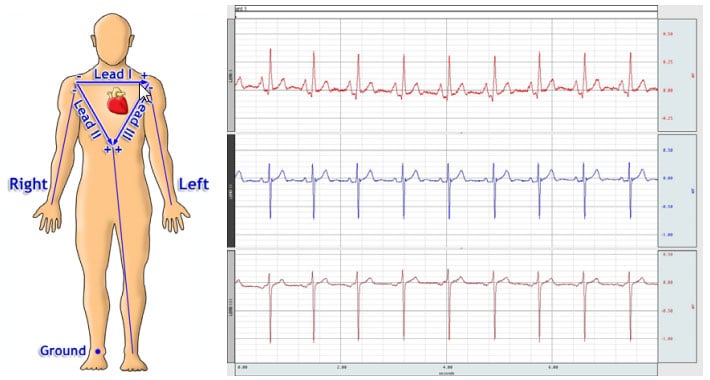109 – 3-, 6-, and 12-Lead ECG
An electrocardiogram (ECG) is a graphic recording of the changes occurring in the electrical potentials between different sites on the skin (leads) as a result of cardiac activity. Depolarization of the cardiac cells is the central electrical event of the heart. This occurs when the cardiac cells, which are electrically polarized, lose their internal negativity. Depolarization is distributed from cell to cell, producing a wave of depolarization that can be transmitted across the entire heart. This wave represents a flow of electricity and it can be detected by electrodes placed on the surface of the body. Once depolarization is complete, the cardiac cells are able to restore their resting polarity through a process called repolarization. This flow of electricity can also be sensed by recording electrodes.

One common placement of the electrodes is based on Einthoven’s triangle, which is an imaginary triangle drawn around the volume of the heart. Each apex of the triangle represents where the body’s composition, around the heart, connects electrically with the limbs. Einthoven’s law states that if the values for any two points of the triangle are known, the third can be computed.
This Application Note details 1-lead ECG, 3-lead ECG, 6-lead ECG, and 12-lead ECG.
See also: Continuous 12-lead ECG – App Note #AH-206
Associated Applications
- Psychophysiology - Record and analyze BP, ECG, HRV, EDA, EMG, EEG, EOG, RSP, etc. Interface to stimulus presentation programs...use automated analysis routines to easily score and analyze data.
- ICG: Impedance Cardiography/Cardiac Output - Record cardiac output, thoracic impedance changes, or any kind of bioimpedance signal. Use AcqKnowledge for a fully automated ICG analysis and dZ/dt waveform classifier.
- Sleep Studies - Long term recordings with up to 16 channels of data. Record EEG, EOG, EMG, respiration, temp., sound, limb position and more. Filter out EEG frequencies to score sleep stages.
- ECG: Cardiology - Connect up to 16 ECG input leads with MP160 system. Use automated analysis features for HRV, RSA, to classify heartbeats, identify arrhythmias, and perform ECG averaging.
- Cardiovascular Hemodynamics - Hardware for human and animals. Measure continuous BP, ECG, stroke volume, cardiac output, PPG, etc. For animal and tissue look at acute and chronic dose-response.
- Respiration | Pulmonary Function - Perform lung volume measurements, examine pressure/volume relationships, and analyze respiratory gases. Use AcqKnowledge to integrate airflow and analyze data.
- Exercise Physiology - Examine ventilation, oxygen uptake, carbon dioxide production, biopotentials, temp., and biomechanical signals simultaneously. Record wirelessly with BioNomadix.
- Biomechanics - Use BIOPAC equipment for gait analysis, goniometry, ergonomics evaluation, range of motion, EMG, Remote Monitoring or to interface with third-party equipment.
- Remote Monitoring - BioNomadix modules provide high quality, full-bandwidth data for a variety of signals—ECG, EEG, EGG, EMG, EOG, PPG, RSP, SKT, Accelerometry, Cardiac Output, Dynamometry, and Heel-Toe Strike.
Stay Connected